Amnesty has just published a good report and action. It calls ‘for the immediate release of 285,000 innocent civilians – including an estimated 50,000 children – being held in cramped and squalid camps in the north of Sri Lanka.’Â
Here are a couple of photos taken from about six months ago of the camps as they were being built:
And here are two from about the same day of the ‘no-fire zone’Â a few miles away:
And here is a picture which I think shows the refugees leaving the war zone and being escorted to the camps.
You can see in the first photo the emblems of a humanitarian agency. The second photo shows the barbed wire surrounding each camp. These were, and are, effectively concentration camps (in the original meaning of the word), and so the dilemma was whether humanitarian agencies should have helped to build and administer them?Â
The next two photos show the conditions that the people who are now in the camps were previously suffering. Thousands died either from direct shelling, or starvation and disease, in the space of a few months. Should the aid agencies have done more to publicise what was happening or spoken out louder for a ceasefire – even if it meant getting thrown out of the country or arrested?Â
Finally, should the agencies have allowed themselves to be used in part of a counter-insurgency campaign by the Government of Sri Lanka in which over a quarter of a million people have been forcibly displaced from their homes – which is a prime facie violation of the laws of armed conflict?
The other relevant bits of law here are the provisions in the Geneva Conventions which permit humanitarian agencies to ‘offer their services’ to state parties but also require them to remain strictly neutral during conflicts (Despite what is sometimes asserted there is no legal ‘right to humanitarian assistance’ and nor are governments ‘obliged to allow’ access to civilians by humanitarian agencies during non-international conflicts) and the humanitarian imperative, which says that the alleviation of human suffering comes before other considerations.
Governments may suspend certain rights during public emergencies – such as liberty and freedom of movement – but are constrained both in what they can do to captured combatants, and other prisoners, and how they treat civilians under their control. Governments may on no account torture people or carry out summary executions, starvation is prohibited as a weapon of war and military forces must attempt to distinguish between military and civilian targets, are prohibited from attacking purely civilian targets and must subject all attacks on military targets which may result in civilian casualties to a principle of proportionality. People charged with criminal offenses have a right to a fair trial. The International Committee of the Red Cross has a recognized role in ensuring that these provisions are upheld in practice and so the denial of access to screening facilities or detention centres are issues of legitimate concern from a humanitarian or human rights perspective.
So what would you have done if you had been working for an aid agency in northern Sri Lanka over the past six months?
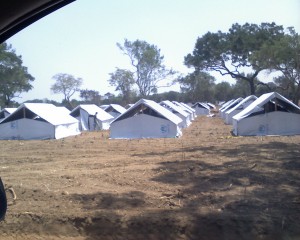
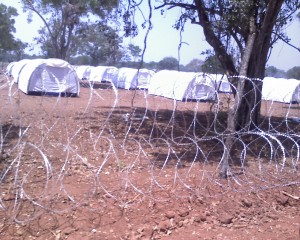
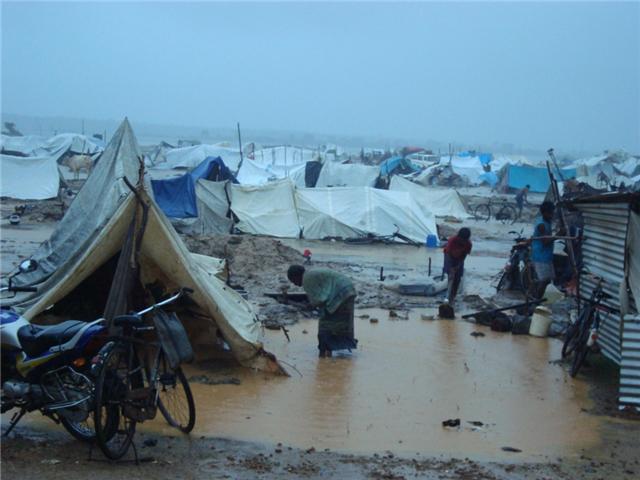
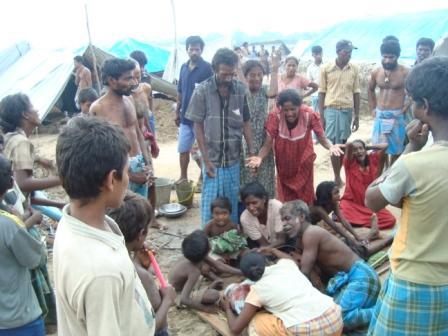
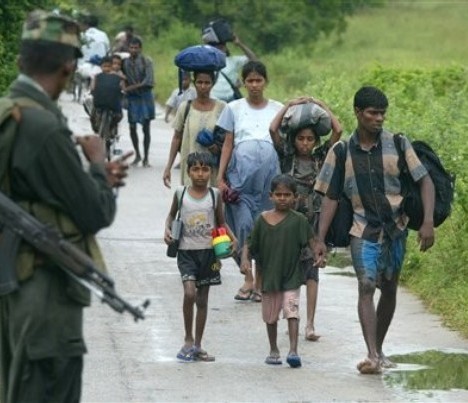
{ 15 comments }
John Quiggin 08.19.09 at 1:15 am
I don’t have an answer to any of these questions, but I’m glad you’ve raised them. The apparent easy answers to the question are made very hard by the fact that the other side in the conflict, the LTTE, was, as far as I can see, worse in every respect than the government – the people in the “no-fire” zone were their prisoners/hostages, as you mention in the linked post.
ajay 08.19.09 at 10:44 am
a quarter of a million people have been forcibly displaced from their homes – which is a prime facie violation of the laws of armed conflict?
Is this really true? I know that permanent displacement is against LOAC, but is that also true of temporary forced evacuation of one’s own citizens out of a war zone?
Zamfir 08.19.09 at 11:27 am
I suppose it works for dramatic effect, but the sunny/rainy day difference between the camp and zone pictures is a bit over the top.
Salient 08.19.09 at 11:56 am
“the humanitarian imperative, which says that the alleviation of human suffering comes before other considerations”
Colin: I am wondering if this is a characterization you’d come up with, or if it can be found in some resource other than ICRC.
[Reason for asking: I’ve been trying to develop a clearer understanding of humanitarian principles from a philosophical/theoretical perspective, and the ICRC is currently my principal source of information and theory. For example, I am hunting for a good discussion of first-principles definitions for what suffering is, specifically to see whether a lack of educational opportunity might be reasonably characterized as a form of suffering.]
Should the aid agencies have done more to publicise what was happening or spoken out louder for a ceasefire – even if it meant getting thrown out of the country or arrested?
It would make more sense, to me, to anonymously provide the relevant information to unaffiliated outlets who would be most likely to publicize it responsibly, and agitate for a ceasefire responsibly. From an institutional standpoint, I don’t know whether that would be legal or appropriate — it probably shouldn’t be official policy.
From the hypothetical standpoint of me the individual working for an aid agency, though, I might’ve tried to do this over an internet proxy or some other reasonably anonymous communication.
Also, “done more to publicize” is kind of problematic. One can always do more for some amorphous definition of more. What specifically did they do to publicize these conditions, and what specifically could they have done? (I’m asking this question sincerely and out of ignorance. It’s entirely possible that what I suggested above either is clearly impossible or was already being done.)
Conor Foley 08.19.09 at 1:11 pm
Salient it is fairly standard ICRC/humanitarian aid speak and was used a lot in the discussions about the camps in Sri Lanka when I was there.
Both the drafters of the Geneva Conventions and the ICRC tend to steer away from giving giving too much detail on precise definitions about the exact nature of suffering, but this is deliberate on their part. In its Commentary on the Geneva Conventions, regarding torture, the International Committee of the Red Cross has stated ‘It is always dangerous to go into too much detail – especially in this domain. However great the care taken in drawing up a list of all the various forms of infliction, it would never be possible to catch up with the imagination of future torturers who wished to satisfy their bestial instincts; the more specific and complete a list tries to be, the more restrictive it becomes. The form of wording adopted is flexible, and, at the same time, precise.’
I wrote a manual a few years ago on torture which has most of the jurisprudence on this issue and may be of some use to you.
http://www.essex.ac.uk/combatingtorturehandbook/
bianca steele 08.19.09 at 2:04 pm
‘concentration camps’
By this, I assume, you mean they were created as a temporary ghetto (in the original meaning of the word) for people whose homes were otherwise perfectly habitable but whose government wanted them residing elsewhere–rather than refugee camps for people no longer living under their home government and not yet having another place to live.
It sounds like international NGOs are constrained by the fact that they cannot work in an area without the permission of the currently ruling faction, and therefore probably tend to see things from the governmental point of view–which seems to be a good argument for encouraging local empowerment. Local groups would be able to take a more confrontational attitude towards oppressive regimes, but this would come at the “cost” of the international agencies’ possibly losing control over the agenda some of the time. It doesn’t solve the immediate problem of alleviating suffering either.
ajay 08.19.09 at 2:33 pm
By this, I assume, you mean they were created as a temporary ghetto (in the original meaning of the word) for people whose homes were otherwise perfectly habitable but whose government wanted them residing elsewhere—rather than refugee camps for people no longer living under their home government and not yet having another place to live
Good point. I think Conor may be wrong to describe the camps as “effectively concentration camps (in the original meaning of the word)”. A concentration camp is a camp into which you force the local population to move (to concentrate, in fact) – for example, in order to more effectively pursue a counterinsurgency campaign, by separating the Boer troops from the Boer civilians who are supporting them.
As far as I’m aware, the people in these camps are refugees from the fighting earlier this year. The compulsion comes in because they’re not yet being allowed to go home now that the fighting’s over – not because they were deliberately and forcibly concentrated in the first place. The camps aren’t concentration camps because there was never any concentrating. They are, or at least Amnesty would argue they are, mass prisons.
As for this: “should the agencies have allowed themselves to be used in part of a counter-insurgency campaign by the Government of Sri Lanka in which over a quarter of a million people have been forcibly displaced from their homes”
inasmuch as the agencies were working to provide aid for the refugees during the fighting, they were not part of the government’s campaign, because as far as I can tell deliberate population shifts weren’t part of the government’s strategy (as they were in South Africa). Inasmuch as they are helping to keep the camps running now the fighting’s over, they’re not part of the campaign either, because there isn’t one.
jacob 08.19.09 at 2:39 pm
The Tamil civilians in the camps are forbidden from leaving and are held there ostensibly in order to prevent them from supporting any remaining Tigers, as well as to somehow find the hidden Tigers in their midst. They are held in the camps indefinitely because they are, by virtue of their ethnicity, suspected of disloyalty to the state. That is classically what concentration camps have been. Ajay attempts to draw a distinction between “mass prisons” and classical concentration camps. I would argue that a mass prison fitting the description in my first two sentences is, by definition, a concentration camp.
ajay 08.19.09 at 2:54 pm
Fair point. But you use the word “ostensibly” – do you think they’re really being kept there for a different reason?
Conor Foley 08.19.09 at 3:18 pm
Bianca: yes I was using the phrase in the Boer war meaning of the term for the reasons that Jacob describes.
Ajay: my life is too short and so far you have been too abusive, arrogant and ill-informed to make it worthwhile to keep responding to you. I am basing this on your comments to all three of my posts so far where you are basically coming across as a juvenile troll. If you moderate your tone and try to engage a bit more with the arguments that are being put across I am happy to reconsider that.
ajay 08.19.09 at 4:40 pm
Just to amplify on 7.2:
should the agencies have allowed themselves to be used in part of a counter-insurgency campaign by the Government of Sri Lanka in which over a quarter of a million people have been forcibly displaced from their homes
– inasmuch as the agencies were working to provide aid for the refugees during the fighting, they were not part of the government’s campaign, because as far as I can tell deliberate population shifts weren’t part of the government’s strategy (as they were in South Africa).
Inasmuch as they are helping to keep the camps running now the fighting’s over, they’re not part of the campaign either, because there isn’t one (the fighting’s over).
So I’d say that the agencies are in the clear as far as their actions in the camps during the conflict goes. (There’s also the distinction between “X has been forcibly evicted from his home as part of a deliberate policy of eviction” and “X has fled his home because it’s in the middle of a war zone and he doesn’t want to die” to consider; from the Amnesty report, the Sri Lanka situation is closer to the latter.)
However, if they’re providing food and services to the camps now, they are presumably helping them continue to exist. While this isn’t siding with one side of the conflict, it’s still, potentially, helping the government pursue its policy of holding thousands of people in camps.
This is a tricky one to consider: if the agencies withdrew, would the government increase its own spending on the camps to compensate (in which case the agencies really are helping the government run the camps) or would it keep spending constant and just let the camp residents sink into misery (in which case the agencies are innocent and neutral, and probably should have stayed in the camps)?
(This sort of problem isn’t limited to Sri Lanka either – the existence of UN camps in Central Africa is causing all sorts of problems for local people and in fact relieving pressure on local governments which might otherwise drive them towards more peaceful policies. David Axe is quite good on this.)
ajay 08.19.09 at 4:42 pm
Posted before I saw 10. Obviously I’m going to have to raise my standard – I’ve always thought of myself as an adolescent troll.
Salient 08.19.09 at 4:56 pm
Both the drafters of the Geneva Conventions and the ICRC tend to steer away from giving giving too much detail on precise definitions about the exact nature of suffering, but this is deliberate on their part.
Thanks for this (it’s good to know my failure to find specific definitions was due to the writers’ intention to maintain sufficient flexibility, not my own inability to find sources.) And I have found and am now reading the Commentary you referenced. [Here, for those interested, the quote can be found under 2A.]
Katherine 08.20.09 at 12:48 pm
It would be interesting to see what the shiny new camps look like now, as well as how they looked 6 months ago having just been built with no one living in them.
The implication from the photos is that the refugees are now living in much better conditions than they were, whatever the rights and wrongs of their mass movement/containment, but it doesn’t seem possible to get a true picture of the whole situation without knowing whether they are still living in much better conditions.
Conor Foley 08.20.09 at 1:22 pm
Katherine,
Good point – and it is worth clarifying that impression in relation to Zamfir’s comment as well.
The first two pictures could have only been taken when the camps were empty. It would be impossible now because of the security. Even six months ago we knew that there was going to be a real problem about conditions (because the first 50,000 IDPs had already arrived and were being accomodated in make-shift camps).
Conditions in the camps are horrible – one recent report said that over 1,000 people are dying in them every week. That is probably an over-estimate (see my previous post about the difficulty of getting acurate numbers), but there is no doubt that the situation is very, very grim and aid agencies are also routinely being denied access to them.
For the aid agencies the dilemma was what type of camps to construct. We knew that the IDPs would not be allowed freedom of movement (ie they would be forcibly detained there) and we were concerned about the issue of forced relocation I referred to above. Since there seems to be some confusion on this point, I should probably elaborate on it a bit.
Forcibly displacing people from their homes – as a deliberate strategy rather than a regretable consequence of a conflict – is a war crime. The best publicised recent example of this took place in the former Yugoslavia where it was dubbed ‘ethnic cleansing’. We saw it in the recent fighting in Georgia as well. Temporarily moving people out of a conflict zone, for their own safety, is acceptable, but this means the issue of how long people are going to be relocated is of vital importance.
Ethnic cleansing has been one of the phenomena of the conflict in Sri Lanka. The LTTE used it against the Muslims of Jaffna and also against Sinhalese civilians. I saw some evidence that it was being perpetrated against Tamils in the north-east of the country which is now under government control.
The suspicion was (and is) that the government wanted to build these camps for the purposes that Jacob outlined above and so we were (and are) worried about creating permanent, or semi-permanent, settlements. That is why the camps just consist of tents and latrines. The structures are deliberately very basic because the aid agencies are accepting government assurances that they are a short-term response. However, the longer people remain forcibly detained there the greater the concern, from both a human rights and humanitarian perspective, which is why the Amnesty action is so important.
Comments on this entry are closed.